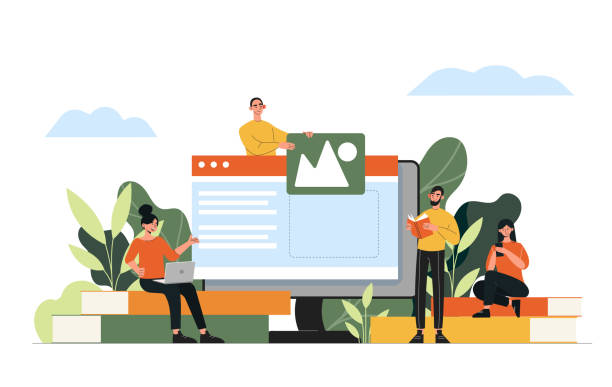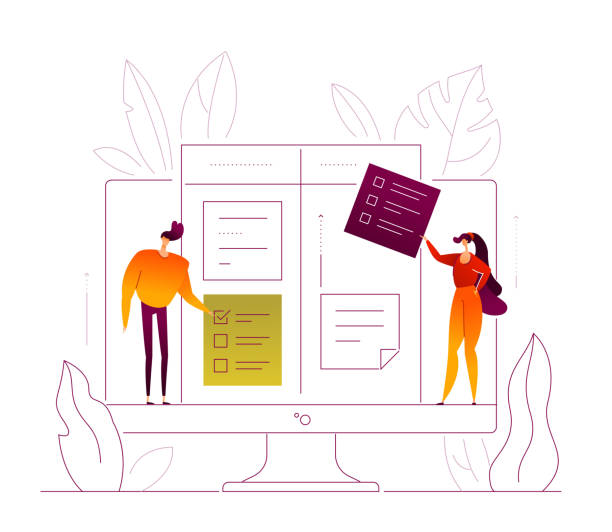The Importance of Secure Website Design in the Digital Age

In today’s world, where the digitalization of life and business has reached its peak, #web_security and #data_protection are no longer a luxury option, but a vital necessity.
Websites, as the main gateways for businesses to connect with customers and users, are constantly targeted by cyberattacks.
These attacks can lead to the theft of sensitive information, loss of brand reputation, extensive financial damages, and even legal repercussions.
For instance, a minor security breach can expose the data of millions of users and have irreparable consequences for an organization.
Therefore, emphasizing website design from the very initial stages gains special importance.
It should be noted that security is not limited to technical layers; it also includes management processes and user awareness.
A website that is not properly designed and managed can easily become a gateway for attackers.
Therefore, a deep understanding of the principles and techniques of secure website design is essential for every developer and business owner to protect their digital assets against increasing cyber threats.
This is a newsworthy and explanatory topic that gains more importance every day.
Did you know that 85% of customers check your company’s website before any interaction?
With Rasaweb, build a corporate website that reflects your credibility.
✅ Increase credibility and customer trust
✅ Attract high-quality leads
⚡ Get free website design consultation
Common Web Security Threats and How to Identify Them

Understanding common threats is the first step in #cyber_security and #attack_prevention.
Cyberattacks on websites are highly diverse and include instances such as SQL Injection, Cross-Site Scripting (XSS), Cross-Site Request Forgery (CSRF), DDoS attacks, and malware injection.
SQL Injection occurs when an attacker manipulates the database by injecting malicious SQL code into website inputs; this can lead to the exposure of sensitive information or even data deletion.
XSS allows an attacker to inject malicious code into the website and execute it in the victim users’ browsers, which can lead to cookie theft or page content alteration.
CSRF is another attack that deceives users into sending unwanted requests to the website on their behalf.
Identifying these threats requires specialized knowledge and the use of appropriate tools.
These tools include vulnerability scanners, Penetration Testing, and continuous monitoring of server logs.
An analytical and educational approach to reviewing logs and traffic patterns can help identify suspicious activities and prevent potential attacks.
A deep understanding of these mechanisms is essential for anyone involved in web development.
Fundamental Principles of Secure Website Design from the Ground Up

Secure website design must begin at the outset of the software development lifecycle, not as a post-completion phase.
Fundamental principles include #input_validation, #data_encryption, and #precise_access_control.
Every user input into the system, whether via forms, URLs, or cookies, must be carefully validated and filtered to prevent attacks such as SQL Injection and XSS.
Outputs must also be properly encoded to prevent malicious code injection into the user’s browser.
Data encryption, both in transit (using SSL/TLS) and at rest (in the database), is vital for protecting sensitive information.
Authentication and access control systems must be robust, utilizing complex passwords, two-factor authentication (2FA), and proper session management.
Furthermore, the Principle of Least Privilege must be adhered to, meaning that users and systems should only have access to the resources essential for their tasks.
Using web development frameworks that have security at their core, such as Django, Laravel, or ASP.NET Core, can significantly help improve security, as these frameworks cover many common vulnerabilities by default.
This specialized approach plays a vital role in guiding and educating developers and contributes to sustainable secure website design.
In addition, here is a table of best practices for secure website design:
| Security Principle | Description |
|---|---|
| Input Validation | All user input data must be checked and sanitized before processing. |
| Session Management | User sessions must be properly created, maintained, and destroyed to prevent session hijacking. |
| Access Control | Users should only have access to resources they are authorized for (Principle of Least Privilege). |
| Encryption | Sensitive data in transit and at rest must be encrypted. |
Choosing Secure Technologies and Platforms for Web Development

The correct selection of platforms and technologies used in #web_development plays a key role in the final security structure of a website.
Modern frameworks and Content Management Systems (CMS) are often designed with security aspects in mind and manage many common vulnerabilities by default.
For example, frameworks like Django (for Python), Laravel (for PHP), and ASP.NET Core (for .NET) have built-in security features such as protection against CSRF, XSS, and SQL Injection.
However, using these frameworks does not mean complete security assurance; rather, the programmer must still adhere to secure coding best practices.
For CMSs like WordPress or Joomla, security depends not only on the system’s core but also on plugins, themes, and server configuration.
It is necessary to always obtain plugins and themes from reputable sources and update them regularly.
Secure server configuration (web server, database, and operating system) also provides an important defensive layer.
Using stable and up-to-date software versions, disabling unnecessary services, and applying appropriate firewall rules are among the vital measures.
These choices and configurations represent a specialized and explanatory approach towards security.
Did you know that poor online store design can drive away up to 70% of your potential customers? Rasaweb transforms your sales with professional and user-friendly e-commerce website design.
✅ Significant increase in sales and revenue
✅ Full optimization for search engines and mobile
⚡ [Get free consultation from Rasaweb]
Implementing SSL/TLS Certificates and Data Encryption

One of the most important steps in #web_communication_security and #trust_building is the implementation of SSL/TLS certificates and the activation of the HTTPS protocol.
HTTPS, which stands for Hypertext Transfer Protocol Secure, is the secure version of HTTP and encrypts the communication between the user’s browser and the website server using SSL/TLS encryption.
This encryption prevents eavesdropping, data manipulation, and identity spoofing, ensuring that transmitted information (such as passwords, credit card details, and personal data) remains private and intact.
Without HTTPS, data is transmitted in plain text, which can be easily intercepted and viewed by attackers.
There are different types of SSL certificates, including Domain Validation (DV), Organization Validation (OV), and Extended Validation (EV), each offering a different level of validation and trust.
Using HTTPS is not only essential for user data security but also positively impacts a website’s SEO ranking, as search engines prefer secure websites.
In addition to data encryption in transit, data encryption at rest in databases and file systems is also crucial for maintaining information confidentiality in case of unauthorized server access.
This is an educational and explanatory approach that strengthens website security.
Vulnerability Management and Continuous Security Updates

#Vulnerability_management and #continuous_software_updates are the cornerstones of a dynamic and resilient secure website design.
Websites and their underlying software are always subject to the discovery of new vulnerabilities.
Attackers constantly seek security gaps to infiltrate systems.
Therefore, it is essential to regularly scan and update website systems to find and fix these vulnerabilities.
This process includes using automated vulnerability scanners, conducting periodic penetration tests by security experts, and monitoring security reports related to the frameworks, libraries, and services used.
Security updates, released by software developers, contain fixes for discovered vulnerabilities.
Failure to install these updates promptly leaves the website vulnerable to known attacks.
Furthermore, a robust Patch Management strategy must be in place to ensure that all systems, from the server operating system to the web platform and plugins, are always up-to-date with the latest security patches.
This is a very important guidance and news recommendation for maintaining website integrity and security.
The Role of Firewalls, WAF, and CDN in Enhancing Website Security

To increase defensive layers and ensure website security, using advanced tools like firewalls, Web Application Firewalls (WAF), and Content Delivery Networks (CDN) is highly effective.
#Network_firewall filters incoming and outgoing traffic based on a set of predefined rules and prevents unauthorized access to the server.
However, for protection against application layer attacks, a WAF is essential.
WAF inspects HTTP/S traffic, identifying and blocking common attack patterns like SQL Injection and XSS.
WAFs can be provided as hardware, software, or cloud services.
CDNs are not only useful for improving website performance and speed but also act as a defensive layer against DDoS attacks by distributing traffic across multiple servers and filtering malicious traffic.
Many CDNs also offer WAF security features.
These tools, working together, create a Defense in Depth strategy, which is crucial for resisting a wide range of attacks.
This section is considered a specialized analysis of security tools.
| Security Tool | Primary Use | Role in Web Security |
|---|---|---|
| Firewall (Network Firewall) | Controls network traffic based on IP and port rules | Protects the server against unauthorized access and port scanning |
| WAF (Web Application Firewall) | Filters and monitors HTTP/S traffic of web applications | Protects against Layer 7 attacks like SQL Injection and XSS |
| CDN (Content Delivery Network) | Distributes content across various geographical servers | Increases web speed and counters DDoS attacks by distributing traffic |
Backup, Data Recovery, and Security Incident Planning

Even with the strongest security measures, the possibility of a security breach or system failure always exists.
For this reason, #regular_backup and #data_recovery_planning are an inseparable part of a secure website design strategy.
Backups should include all website data, databases, configuration files, and source code.
These backups should be stored in a secure location, preferably off-site from the main server, and encrypted.
Regular testing of the data recovery process is of high importance to ensure that, in the event of a disaster, information can be restored.
In addition to backups, having an Incident Response Plan is essential for managing security incidents.
This plan should include phases for identification, containment, eradication, recovery, and lessons learned from incidents.
Continuous monitoring of systems and logs can also help in early detection of suspicious activities.
Training the support and technical team to implement these protocols significantly increases the speed and efficiency of incident response.
This educational and guidance approach is for ensuring website resilience against potential risks.
Does your current website convert visitors into customers or drive them away? Solve this problem forever with professional corporate website design by Rasaweb!
✅ Building credibility and powerful branding
✅ Attracting target customers and increasing sales
⚡ Get a free consultation now!
User Awareness and Security Training: The Missing Link in Secure Website Design

Often, the weakest link in the security chain is the human factor.
Even if a website is built with full adherence to the principles of secure website design, user unawareness or carelessness can open a gateway for attackers.
Attacks such as #phishing, social engineering, and the use of #weak_passwords are examples of these human vulnerabilities.
Therefore, user security education and awareness are as important as technical measures.
These trainings should cover how to detect phishing emails, the importance of using strong and unique passwords, activating two-factor authentication, and avoiding clicking on suspicious links.
This topic can be posed in an engaging and thought-provoking way: Do users sufficiently understand their responsibility for data security? Organizations should actively implement continuous training programs for their employees and even their users (in the form of articles, guides, and infographics).
This investment in cybersecurity awareness can significantly reduce risks stemming from human error and add a powerful, non-technical defensive layer to the website’s security architecture.
The Future of Secure Website Design: AI and New Challenges

The world of cybersecurity is constantly evolving, and with the emergence of new technologies, new challenges and opportunities for #future_security and #secure_web_development arise.
Artificial Intelligence (AI) and Machine Learning (ML) are changing the landscape of secure website design.
On one hand, attackers use AI to automate attacks, intelligent phishing, and vulnerability identification.
On the other hand, AI and ML provide powerful tools for cyber defense, including anomaly detection in network traffic, threat analysis, and automated response to security incidents.
Technologies like blockchain also hold potential for increasing security and privacy, especially in identity management and data security.
However, with technological advancement, new challenges also emerge, such as Internet of Things (IoT) security and quantum attacks.
To maintain website security in the future, development and security teams must constantly stay abreast of the latest developments, adopt new analytical approaches, and implement innovative solutions for secure web development.
This is a newsworthy and analytical topic that requires a forward-looking perspective.
Frequently Asked Questions
| Row | Question | Answer |
|---|---|---|
| 1 | What is secure website design? | The process of designing and developing websites that are resistant to cyberattacks and protect user data and privacy. |
| 2 | Why is website security important? | To prevent data breaches, financial losses, damage to company reputation, and to maintain user trust. |
| 3 | What are some common website security threats? | SQL Injection, XSS (Cross-Site Scripting), CSRF (Cross-Site Request Forgery), weak authentication, and unpatched software. |
| 4 | What is SSL/TLS and what is its role? | Protocols for encrypting data between the user’s browser and the website server, ensuring secure and private communication. |
| 5 | How can SQL Injection attacks be prevented? | By using Prepared Statements/Parameterized Queries, input validation, and ORMs (Object-Relational Mappers). |
| 6 | What is the role of a Web Application Firewall (WAF) in security? | A WAF monitors and filters HTTP traffic between a web application and the internet to prevent malicious attacks. |
| 7 | Why are regular updates of software and libraries essential? | Updates include patches for known security vulnerabilities that attackers can exploit. |
| 8 | How can XSS attacks be prevented? | By sanitizing and escaping all user inputs before displaying them on the web page and using a Content Security Policy (CSP). |
| 9 | What is the Principle of Least Privilege? | It means that users and systems are granted only the minimum necessary permissions to perform their tasks, preventing unnecessary access to resources. |
| 10 | What is the importance of proper Session Management? | To prevent user session hijacking and unauthorized access to user accounts through secure and expiring session tokens. |
And other services of Rasaweb Advertising Agency in the field of advertising
- Smart Sales Automation: A dedicated service for increasing website traffic based on attractive UI design.
- Smart Sales Automation: An innovative service for increasing sales through custom programming.
- Smart UI/UX: Designed for businesses seeking digital branding through key page optimization.
- Smart Link Building: Professional optimization for customer acquisition using attractive UI design.
- Smart Customer Journey Map: An effective tool for improving SEO ranking with SEO-driven content strategy.
And hundreds of other services in the field of internet advertising, advertising consultation, and organizational solutions
Internet Advertising | Advertising Strategy | Advertorials
Resources
What is website security and how to ensure it?
Website Security: How to Enhance It in a Few Steps
Website Security Checklist: 10 Tips to Keep Your Site Secure
Important Tips for Enhancing Website Security
? Are you ready to transform your business in the digital world? Rasaweb Afarin Digital Marketing Agency offers innovative solutions for your growth and success, including comprehensive services such as corporate website design and SEO. For more information and a free consultation, contact us.
📍 Tehran, Mirdamad Street, next to Central Bank, Southern Kazeroun Alley, Ramin Alley, No. 6


